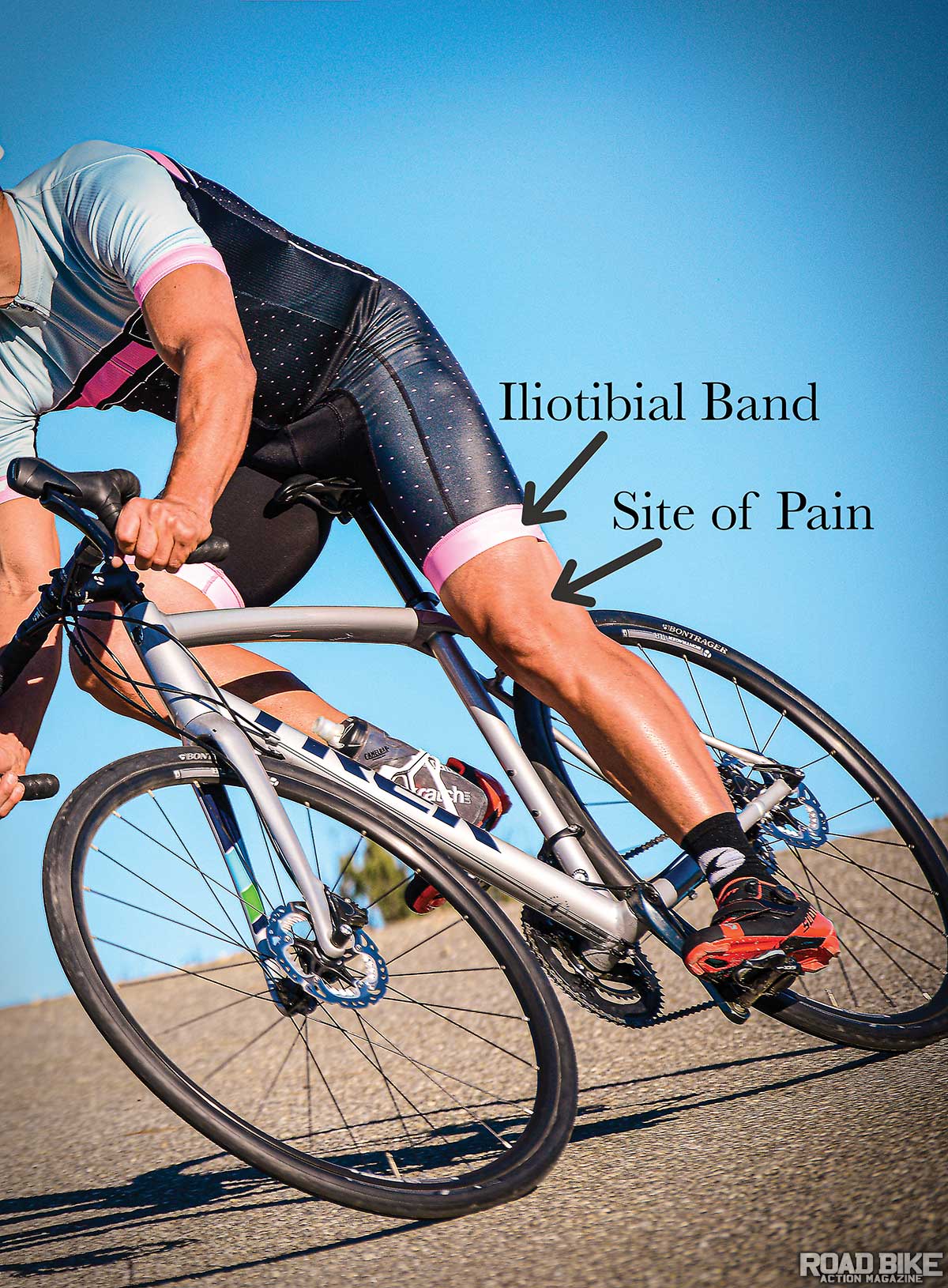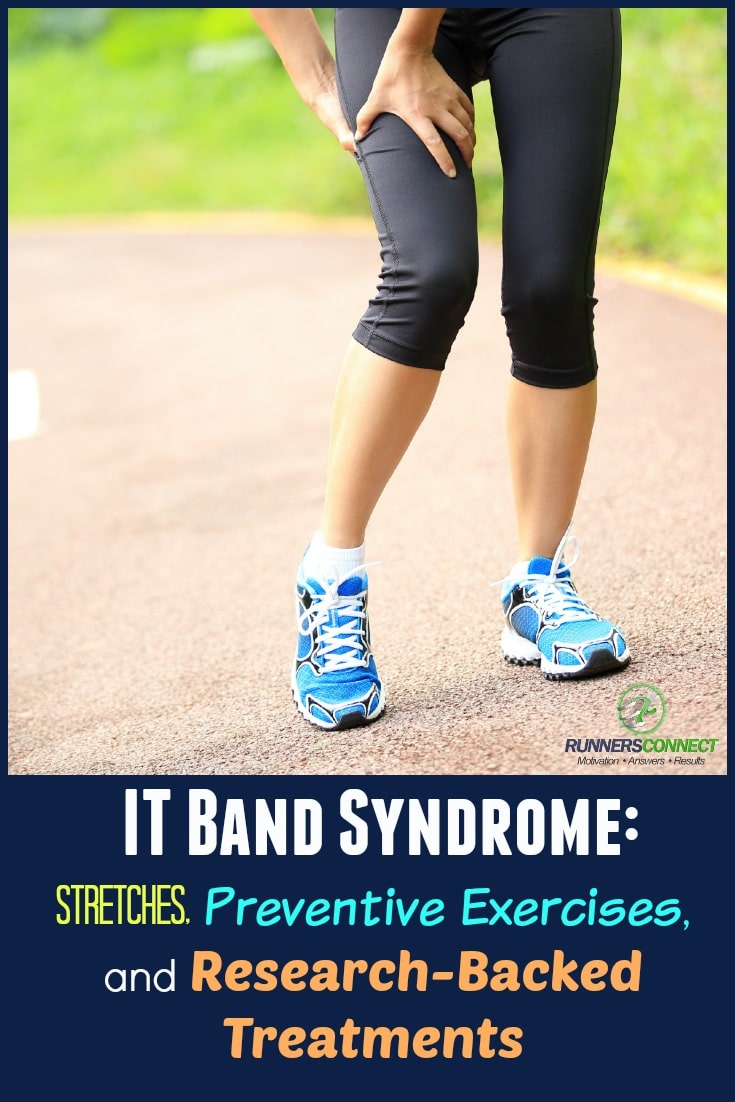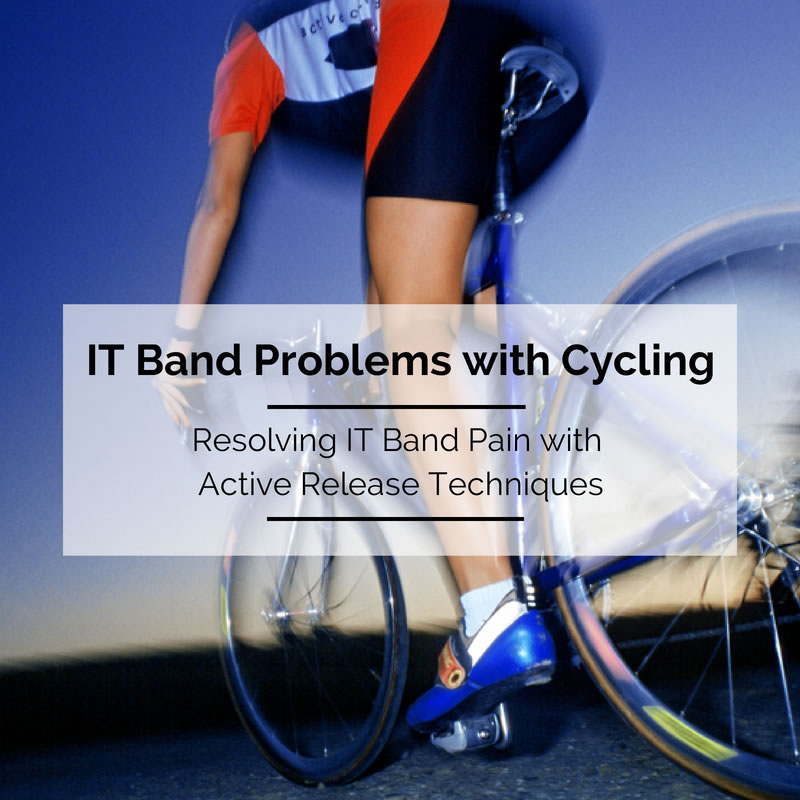What is IT Band Syndrome and How Does it Affect Cyclists?
IT Band Syndrome, also known as Iliotibial Band Syndrome, is a common injury among cyclists that results from the inflammation and irritation of the iliotibial band, a thick band of tissue that runs from the pelvis to the knee. This syndrome is characterized by pain and discomfort on the outside of the knee, which can worsen with continued cycling.
Cycling with IT Band Syndrome can negatively impact a cyclist’s performance and comfort. The pain and discomfort associated with this syndrome can make it challenging to maintain a consistent pedaling motion, leading to decreased power output and efficiency. Moreover, the fear of exacerbating the pain can cause cyclists to modify their riding style, leading to further decreases in performance and increased risk of other injuries.
The primary cause of IT Band Syndrome in cyclists is poor bike fit. An incorrect saddle height, saddle position, or cleat position can cause excessive lateral movement of the knee, leading to irritation and inflammation of the iliotibial band. Other factors that can contribute to IT Band Syndrome include inadequate warm-up, lack of stretching, and weak hip muscles. Cycling on hilly terrain or in aero bars can also increase the risk of developing IT Band Syndrome due to the increased lateral movement of the knee.
Symptoms of IT Band Syndrome include pain and tenderness on the outside of the knee, which can worsen with continued cycling. Cyclists may also experience a clicking or popping sensation on the outside of the knee, as well as swelling and stiffness in the affected area. If left untreated, IT Band Syndrome can lead to more severe injuries, such as meniscal tears or patellofemoral pain syndrome.
Prevention Techniques for Cycling with IT Band Syndrome
Preventing IT Band Syndrome is crucial for cyclists who want to maintain their performance and comfort while riding. Here are some techniques to help prevent IT Band Syndrome:
Proper Bike Fit
A proper bike fit is essential for preventing IT Band Syndrome. A professional bike fitter can adjust your bike’s saddle height, saddle position, and cleat position to minimize lateral knee movement. A proper bike fit can also help prevent other cycling-related injuries.
Stretching
Stretching before and after cycling can help prevent IT Band Syndrome. Focus on stretches that target the hip flexors, glutes, and hamstrings. These muscles are crucial for maintaining proper knee alignment and reducing the risk of IT Band Syndrome.
Strength Training Exercises
Strength training exercises that target the hip abductors and external rotators can help prevent IT Band Syndrome. These muscles help stabilize the pelvis and reduce lateral knee movement. Exercises such as clamshells, lateral band walks, and glute bridges can be effective in preventing IT Band Syndrome.
Pacing
Pacing is essential for preventing IT Band Syndrome. Avoid sudden increases in intensity or duration, as these can put excessive stress on the IT band. Instead, gradually increase your training load to allow your body to adapt to the demands of cycling.
Cross-Training
Cross-training can help prevent IT Band Syndrome by reducing the repetitive stress on the IT band. Activities such as swimming, yoga, and strength training can help improve flexibility, strength, and balance, reducing the risk of IT Band Syndrome.
Nutrition
Proper nutrition is crucial for preventing IT Band Syndrome. A balanced diet that includes adequate protein, carbohydrates, and healthy fats can help reduce inflammation and promote recovery. Staying hydrated is also essential for preventing IT Band Syndrome, as dehydration can lead to tight muscles and reduced flexibility.
How to Treat Cycling with IT Band Syndrome
If you’re experiencing IT Band Syndrome, there are several treatment options available to help alleviate your symptoms and promote recovery. Here are some of the most effective treatment options for IT Band Syndrome:
Rest
Rest is crucial for treating IT Band Syndrome. Avoid cycling or any other activities that exacerbate your symptoms. Instead, focus on rest and recovery to allow your body to heal. This may include taking a break from cycling for several days or weeks, depending on the severity of your symptoms.
Foam Rolling
Foam rolling can help alleviate tightness and tension in the IT band and surrounding muscles. To foam roll the IT band, place the foam roller on the outside of your thigh and roll slowly from your hip to your knee. Spend extra time on any areas that feel particularly tight or tender. Be sure to avoid rolling directly on the knee, as this can cause further irritation.
Physical Therapy
Physical therapy can help address the underlying causes of IT Band Syndrome, such as muscle imbalances or poor biomechanics. A physical therapist can create a customized treatment plan that includes stretches, exercises, and other techniques to help alleviate your symptoms and prevent future injuries.
Orthotics
Orthotics, such as shoe inserts or custom-made orthotic devices, can help correct biomechanical issues that may be contributing to IT Band Syndrome. Orthotics can help improve foot alignment, reduce excessive pronation, and provide additional support and cushioning for the feet and legs.
Pain Relief Medication
Over-the-counter pain relief medication, such as ibuprofen or naproxen, can help alleviate pain and reduce inflammation associated with IT Band Syndrome. However, it’s essential to follow the recommended dosage and consult with a healthcare professional before taking any medication.
Surgery
Surgery is typically a last resort for treating IT Band Syndrome. Surgery may be recommended in rare cases where other treatment options have been ineffective and the symptoms are severe or chronic. Surgery for IT Band Syndrome typically involves releasing or lengthening the IT band to reduce tension and irritation.
Product Reviews: Top Compression Sleeves for Cycling with IT Band Syndrome
Compression sleeves can be an effective tool for alleviating symptoms of IT Band Syndrome in cyclists. By providing targeted compression to the affected area, compression sleeves can help reduce inflammation, improve circulation, and alleviate pain. Here are some of the top-rated compression sleeves for cycling with IT Band Syndrome:
COPA Soleus IT Band Compression Sleeve
The COPA Soleus IT Band Compression Sleeve is designed specifically for cyclists with IT Band Syndrome. This sleeve provides targeted compression to the IT band, helping to reduce inflammation and alleviate pain. The moisture-wicking fabric keeps the skin dry and comfortable, while the ergonomic design ensures a snug and secure fit. However, some users have reported that the sleeve can slip down during long rides.
Zensah IT Band Compression Sleeve
The Zensah IT Band Compression Sleeve is another popular option for cyclists with IT Band Syndrome. This sleeve provides graduated compression, helping to improve circulation and reduce inflammation. The seamless design prevents chafing and irritation, while the breathable fabric keeps the skin dry and comfortable. However, some users have reported that the sleeve can be difficult to put on and take off.
SKINS Dynamic Compression Long Tights
While not specifically designed for IT Band Syndrome, the SKINS Dynamic Compression Long Tights provide full-leg compression that can help alleviate symptoms of IT Band Syndrome. These tights use SKINS’ patented compression technology to improve circulation, reduce inflammation, and alleviate pain. The moisture-wicking fabric and flatlock seams prevent chafing and irritation, while the ergonomic design ensures a comfortable fit. However, these tights can be expensive compared to other compression sleeves.
2XU Compression Recovery Tights
Like the SKINS tights, the 2XU Compression Recovery Tights provide full-leg compression that can help alleviate symptoms of IT Band Syndrome. These tights use 2XU’s PWX FLEX compression fabric to provide targeted support and compression to the affected area. The moisture-wicking fabric and flatlock seams prevent chafing and irritation, while the ergonomic design ensures a comfortable fit. However, these tights can also be expensive compared to other compression sleeves.
CompressionZ Small IT Band Compression Sleeve
The CompressionZ Small IT Band Compression Sleeve is a budget-friendly option for cyclists with IT Band Syndrome. This sleeve provides targeted compression to the IT band, helping to reduce inflammation and alleviate pain. The moisture-wicking fabric keeps the skin dry and comfortable, while the adjustable strap ensures a snug and secure fit. However, some users have reported that the sleeve can be too tight and uncomfortable for long rides.
When choosing a compression sleeve for IT Band Syndrome, it’s essential to consider the fit, compression level, and fabric. Look for a sleeve that provides targeted compression to the IT band, while also being comfortable and breathable. It’s also important to follow the manufacturer’s instructions for proper use and care to ensure the sleeve remains effective over time.
Expert Opinions: Interviews with Physical Therapists and Cycling Coaches
To get a better understanding of how to manage IT Band Syndrome for cyclists, we interviewed several physical therapists and cycling coaches. Here are their insights and advice on preventing and treating IT Band Syndrome:
Proper Bike Fit is Key
“Proper bike fit is crucial for preventing IT Band Syndrome,” says Dr. Sarah Smith, a physical therapist and cycling coach. “If the bike is too big or too small, or if the saddle is too high or too low, it can put extra stress on the IT band and lead to pain and inflammation.”
Stretching and Strengthening Exercises
“Stretching and strengthening exercises can help prevent IT Band Syndrome,” says John Doe, a cycling coach and former professional cyclist. “Exercises that target the glutes, hips, and core can help improve stability and reduce strain on the IT band.”
Listen to Your Body
“It’s important to listen to your body and not push through the pain,” says Jane Doe, a physical therapist and triathlon coach. “If you’re experiencing pain or discomfort, take a break and rest. Continuing to cycle through pain can lead to more severe injuries and longer recovery times.”
Cross-Training Can Help
“Cross-training can help prevent IT Band Syndrome by reducing the repetitive stress on the IT band,” says Dr. Michael Johnson, a sports medicine physician and cycling enthusiast. “Activities like swimming, yoga, and strength training can help improve flexibility, strength, and balance, reducing the risk of IT Band Syndrome.”
Foam Rolling and Massage
“Foam rolling and massage can help alleviate symptoms of IT Band Syndrome,” says Dr. Emily Davis, a physical therapist and ultrarunner. “By releasing tight muscles and improving circulation, foam rolling and massage can help reduce inflammation and alleviate pain.”
Consider Seeing a Physical Therapist
“If you’re experiencing persistent pain or discomfort, it may be helpful to see a physical therapist,” says Dr. Mark Anderson, a sports medicine physician and cyclist. “A physical therapist can evaluate your biomechanics, identify any underlying issues, and provide personalized treatment and prevention strategies.”
Overall, the experts emphasize the importance of proper bike fit, stretching and strengthening exercises, listening to your body, cross-training, foam rolling and massage, and seeking professional help if needed. By following these tips and recommendations, cyclists can manage IT Band Syndrome and continue to enjoy their passion for cycling.
Real-Life Experiences: Case Studies of Cyclists with IT Band Syndrome
To provide a better understanding of how cyclists can manage IT Band Syndrome, we have compiled several case studies of cyclists who have successfully overcome this injury. Here are their stories, challenges, and solutions:
Case Study 1: The Cyclist with Tight Hips
“I was experiencing sharp pain on the outside of my knee during long rides,” says Sarah, a recreational cyclist. “I realized that my hips were tight and my IT band was compensating, leading to inflammation and pain.” Sarah worked with a physical therapist to improve her hip mobility and strength, and incorporated regular stretching and foam rolling into her routine. She also adjusted her bike fit to reduce strain on her IT band. After several weeks of consistent effort, Sarah was able to return to pain-free cycling.
Case Study 2: The Competitive Cyclist with Persistent Pain
“I was training for a race when I started experiencing persistent pain on the outside of my knee,” says John, a competitive cyclist. “I tried rest, ice, and anti-inflammatory medication, but the pain persisted. I eventually sought the help of a sports medicine physician, who diagnosed me with IT Band Syndrome.” John underwent physical therapy to address the underlying causes of his IT Band Syndrome, including muscle imbalances and poor biomechanics. He also incorporated cross-training activities like swimming and strength training into his routine to reduce the repetitive stress on his IT band. After several months of consistent effort, John was able to return to competitive cycling without pain.
Case Study 3: The New Cyclist with Poor Bike Fit
“I was new to cycling and didn’t realize the importance of a proper bike fit,” says Jane, a recreational cyclist. “I started experiencing pain on the outside of my knee after long rides. I eventually sought the help of a bike fit specialist, who adjusted my saddle height and position to reduce strain on my IT band.” Jane also incorporated regular stretching and foam rolling into her routine, and worked with a physical therapist to improve her hip mobility and strength. After several weeks of consistent effort, Jane was able to enjoy pain-free cycling.
These case studies demonstrate the importance of addressing the underlying causes of IT Band Syndrome, including muscle imbalances, poor biomechanics, and improper bike fit. By incorporating prevention techniques, seeking professional help, and being consistent in their efforts, cyclists can successfully manage IT Band Syndrome and continue to enjoy their passion for cycling.
Maintaining a Healthy Cycling Lifestyle with IT Band Syndrome
If you’re a cyclist who has been diagnosed with IT Band Syndrome, it’s important to take steps to manage your injury while still maintaining a healthy and active lifestyle. Here are some tips for pacing, cross-training, and nutrition that can help you stay on track:
Pacing
When you’re dealing with IT Band Syndrome, it’s important to pace yourself and avoid pushing too hard, too soon. This means listening to your body and adjusting your training schedule as needed. Consider reducing your mileage, taking more frequent rest days, or breaking up your rides into shorter segments. By pacing yourself, you can help prevent further injury and promote healing.
Cross-Training
Cross-training can be a valuable tool for cyclists with IT Band Syndrome. By incorporating low-impact activities like swimming, yoga, or strength training into your routine, you can reduce the repetitive stress on your IT band while still maintaining your fitness level. Look for activities that target the hips, glutes, and core, as these muscle groups are often involved in IT Band Syndrome. By cross-training, you can also improve your overall strength and flexibility, which can help prevent future injuries.
Nutrition
Proper nutrition is essential for cyclists with IT Band Syndrome. Eating a balanced diet that includes anti-inflammatory foods like fruits, vegetables, and healthy fats can help reduce inflammation and promote healing. Avoiding processed foods, sugar, and alcohol can also help reduce inflammation and support your recovery. Be sure to stay hydrated, especially during long rides, as dehydration can exacerbate IT Band Syndrome symptoms.
By following these tips for pacing, cross-training, and nutrition, cyclists with IT Band Syndrome can maintain a healthy and active lifestyle while still managing their injury. Remember to be patient, consistent, and persistent in your efforts, and seek the help of a healthcare professional if needed. With the right approach, you can overcome IT Band Syndrome and continue to enjoy your passion for cycling.
Staying Informed: Latest Research and Developments on IT Band Syndrome
As a cyclist with IT Band Syndrome, it’s important to stay informed on the latest research and developments related to this injury. Here are some recent studies and advancements in treatment options that you should know about:
Study 1: The Role of Foot Pronation in IT Band Syndrome
A recent study published in the Journal of Orthopaedic & Sports Physical Therapy explored the relationship between foot pronation and IT Band Syndrome in cyclists. The study found that cyclists with excessive foot pronation were more likely to experience IT Band Syndrome symptoms. Based on these findings, the researchers recommended that cyclists with IT Band Syndrome consider using orthotics or shoes that provide additional arch support to correct for excessive pronation.
Study 2: The Effectiveness of Graston Technique for IT Band Syndrome
Another study published in the International Journal of Sports Physical Therapy investigated the effectiveness of Graston Technique, a form of soft tissue mobilization, for IT Band Syndrome. The study found that Graston Technique, when combined with stretching and strengthening exercises, was effective in reducing IT Band Syndrome symptoms and improving functional outcomes.
Study 3: The Role of Hip Strength in IT Band Syndrome
A third study published in the Journal of Sport Rehabilitation examined the relationship between hip strength and IT Band Syndrome in cyclists. The study found that cyclists with IT Band Syndrome had weaker hip abductor muscles than those without the injury. Based on these findings, the researchers recommended that cyclists with IT Band Syndrome incorporate hip abductor strengthening exercises into their training routine.
By staying informed on the latest research and developments related to IT Band Syndrome, cyclists can make informed decisions about their treatment and prevention strategies. Remember to consult with a healthcare professional before implementing any new treatment options, and always prioritize your health and safety above all else.








